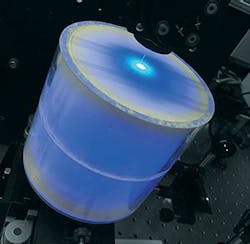Laser phosphorescence detects trace human waste contamination in water
(Image: Texas A&M University)
A laser-phosphorescence cavity-enhanced spectroscopic technique capable of sampling water systems to find indicators of fecal-matter contamination at concentrations that are thousandths and even millionths of times more dilute than those found by conventional methods is being developed by a team of researchers at Texas A&M University (College Station, TX), Princeton University (Princeton, NJ), and Baylor University (Waco, TX).1 The technique is suitable for use in both developed and developing countries.
The technique detects urobilin, which is a metabolic byproduct of heme metabolism excreted in the urine and feces of many mammals, including humans and livestock such as cows, horses, and pigs. Urobilin molecules are small and diffuse quickly so they easily occupy large volumes, such as lakes and reservoirs, for example, notes Vladislav Yakovlev, one of the Texas A&M researchers. When mixed with zinc ions, urobilin forms a phosphorescent compound that glows under UV light, says Yakovlev.
The water sample to be tested is placed in an integrated cavity (developed in Yakovlev’s laboratory), where it interacts with zinc ions; laser light enters through a small hole in the cavity, which also serves as the exit port for the phosphorescence.
nM/l detection capability
Using the integrated cavity in their detection efforts, Yakovlev and his team have detected the presence of urobilin down to a nanomole per liter. In addition, the technology quickly provides actual concentration levels of the contaminant. “This is a huge improvement in terms of sensitivity, and our technique has tremendous potential for analysis of global drinking water supplies, particularly in developing nations and following natural disasters, where sophisticated laboratory equipment may not be available,” Yakovlev says.
The hardware can easily analyze large samples ten liters and greater in volume if necessary. A larger sample gives researchers better predictive power about what the water system contains, says Yakovlev. "Using one liter will increase sensitivity by a factor of 20, and an additional ten liters result in another order-of-magnitude increase in sensitivity," he notes.
The group is working to commercialize its technology for urobilin detection.
Source: http://engineering.tamu.edu/news/2014/05/05/fecal-matter-detection
REFERENCE:
1. Joel N. Bixler et al., PNAS (2014); www.pnas.org/cgi/doi/10.1073/pnas.1403175111
